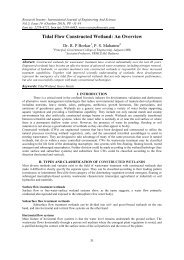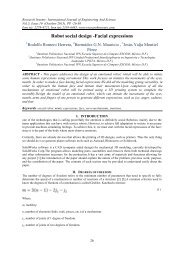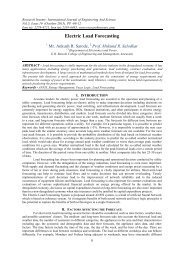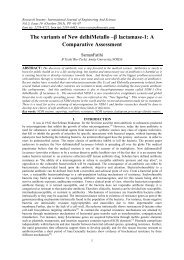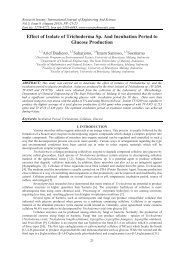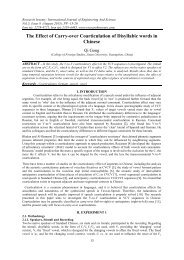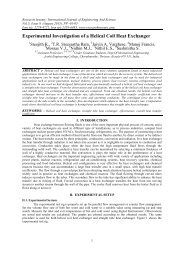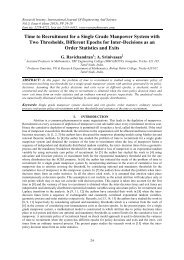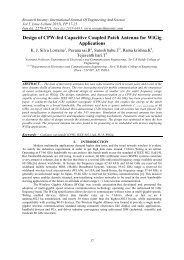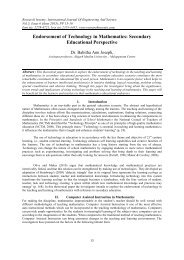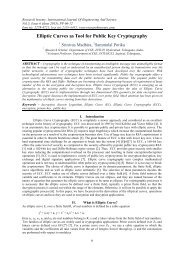A Study on Stabilization of Black Cotton Soil by Use of Fly Ash, Ferric Chloride and Stone Dust
Research Inventy : International Journal of Engineering and Science is published by the group of young academic and industrial researchers with 12 Issues per year. It is an online as well as print version open access journal that provides rapid publication (monthly) of articles in all areas of the subject such as: civil, mechanical, chemical, electronic and computer engineering as well as production and information technology. The Journal welcomes the submission of manuscripts that meet the general criteria of significance and scientific excellence. Papers will be published by rapid process within 20 days after acceptance and peer review process takes only 7 days. All articles published in Research Inventy will be peer-reviewed.
Research Inventy : International Journal of Engineering and Science is published by the group of young academic and industrial researchers with 12 Issues per year. It is an online as well as print version open access journal that provides rapid publication (monthly) of articles in all areas of the subject such as: civil, mechanical, chemical, electronic and computer engineering as well as production and information technology. The Journal welcomes the submission of manuscripts that meet the general criteria of significance and scientific excellence. Papers will be published by rapid process within 20 days after acceptance and peer review process takes only 7 days. All articles published in Research Inventy will be peer-reviewed.
Create successful ePaper yourself
Turn your PDF publications into a flip-book with our unique Google optimized e-Paper software.
A <str<strong>on</strong>g>Study</str<strong>on</strong>g> <strong>on</strong> Stabilizati<strong>on</strong> <strong>of</strong> <strong>Black</strong> Cott<strong>on</strong> <strong>Soil</strong> <strong>by</strong> <strong>Use</strong>…<br />
• California Bearing Ratio (CBR): This test was c<strong>on</strong>ducted as per guidelines <strong>of</strong> IS:2720:XVI-1979 <strong>on</strong><br />
treated <strong>and</strong> untreated black cott<strong>on</strong> soil samples.<br />
IV. RESULTS AND DISCUSSIONS<br />
The effect <strong>of</strong> additi<strong>on</strong> <strong>of</strong> fly ash, ferric chloride <strong>and</strong> st<strong>on</strong>e dust in various porti<strong>on</strong>s <strong>on</strong> properties <strong>of</strong> black cott<strong>on</strong><br />
soil is tabled below-<br />
Table-6 The effect <strong>of</strong> additi<strong>on</strong> <strong>of</strong> fly ash, FeCl3 <strong>and</strong> st<strong>on</strong>e dust <strong>on</strong> properties B. C. soil<br />
Samples as per<br />
Table-5<br />
L.L.<br />
(%)<br />
P.L.<br />
(%)<br />
M.D.D. (g/cm³) O.M.C.<br />
(%)<br />
C.B.R.<br />
(%)<br />
BC1 58 24 1.624 23 1.92<br />
BC2 56 23.95 1.638 22.82 2.32<br />
BC3 54 25.50 1.723 22.52 2.78<br />
BC4 51 26.50 1.813 21.48 3.82<br />
BC5 46 26.80 1.852 20.85 4.95<br />
BC6 45 26.30 1.915 20.12 5.20<br />
Effect <strong>of</strong> additi<strong>on</strong> <strong>of</strong> fly ash, FeCl3 <strong>and</strong> st<strong>on</strong>e dust <strong>on</strong> Atterberg’s limit: It was observed that when<br />
percentage <strong>of</strong> additi<strong>on</strong> <strong>of</strong> fly ash, FeCl3 <strong>and</strong> st<strong>on</strong>e dust increased there was c<strong>on</strong>siderable decrease in liquid limit<br />
<strong>of</strong> black cott<strong>on</strong> soil <strong>and</strong> it goes down to 22.41% <strong>on</strong> sample BC5 ( B.C. soil+2.5% FeCl3+15% <strong>Fly</strong> ash+ 25%<br />
St<strong>on</strong>e dust). The figure below shows the variati<strong>on</strong> in liquid limit <strong>and</strong> plastic limit with different compositi<strong>on</strong>s <strong>of</strong><br />
fly ash, FeCl3 <strong>and</strong> st<strong>on</strong>e dust. The increase in plastic limit <strong>and</strong> decrease in liquid limit causes a net reducti<strong>on</strong> in<br />
plasticity index (P.I.). It was observed that reducti<strong>on</strong> in plasticity index was 45 for sample BC6 (B.C. soil+2.5%<br />
FeCl3+15% <strong>Fly</strong> ash+ 25% St<strong>on</strong>e dust). The improvement in the properties <strong>of</strong> B.C. soil could be the presence <strong>of</strong><br />
ferric chloride in the compositi<strong>on</strong> <strong>of</strong> the mix which is resp<strong>on</strong>sible for depressi<strong>on</strong> <strong>of</strong> double layer thickness due to<br />
readiness <strong>of</strong> cati<strong>on</strong> exchange <strong>and</strong> increase in electrolyte c<strong>on</strong>centrati<strong>on</strong> as the chemical fully dissolves in water.<br />
Effect <strong>of</strong> additi<strong>on</strong> <strong>of</strong> fly ash, FeCl3 <strong>and</strong> st<strong>on</strong>e dust <strong>on</strong> maximum dry density <strong>and</strong> O.M.C.- It can be seen<br />
from the figure-4 that when percentage <strong>of</strong> ferric chloride, fly ash <strong>and</strong> st<strong>on</strong>e dust increases the M.D.D. increases<br />
from 1.624 g/cm³ to 1.915 g/cm³ for FeCl3 2.5%, fly ash 15% <strong>and</strong> st<strong>on</strong>e dust 25% compositi<strong>on</strong>. The increase in<br />
maximum dry density implies that the strength <strong>of</strong> soil has increased. This may be explained due to formati<strong>on</strong> <strong>of</strong><br />
Silicacious material <strong>and</strong> cati<strong>on</strong> exchange reacti<strong>on</strong>.<br />
It was also observed <strong>by</strong> the figure-5 that there is a decrease in O.M.C. as the percentage <strong>of</strong> ferric chloride, fly<br />
ash <strong>and</strong> st<strong>on</strong>e dust increases.<br />
23



